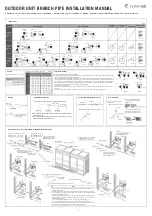
MOTOR CONTACTOR
The motor controller (contactor) is a load current carrying device which makes and breaks to start and stop the compres-
sor motor. The magnetic coil of the controller is energized to make and break the contactor contacts. Frequently, motor
contactors are subjected to quick cycling due to various causes. This may cause burned and/or sticking contacts and can
cause a compressor motor failure, even though the motor overload protectors trip and open the control circuit.
FAN MOTOR
The condenser fan motor is a single speed electrical motor with ball bearings, protected with an automatic reset internal overload.
CRANKCASE HEATERS
The function of the crankcase heater is to hold the compressor oil reservoir at a temperature higher than the coldest part
of the system. The low wattage heaters are energize continuously and it is not necessary to have them de-energize when
the compressor is operating.
Power must be supplied to crankcase heater for minimum of 12 hours prior to system start up. If power is off 6 hours or
more, crankcase heater must be on for 12 hours before operating the system. Failure to follow these instructions may
result in compressor damage.
Crankcase heaters are effective to retard migration of liquid refrigerant to the crankcase during off cycle. But they are not
a remedy for slugging or flood back due to liquid refrigerant accumulating in a trapped suction line, improper piping
practice, over feeding to the evaporator, leaking solenoid valve, etc.
In some cases where migration of refrigerant to the crankcase occurred due to long storage time, shutdown period,
defective components, etc. The crankcase heater may be ineffective. Such cases may be easily observed by high oil
level and cold crankcase. In these cases, it is highly recommended to front seat or close both suction and discharge
service valves of the compressor and release all liquid refrigerant from the compressor.
The liquid refrigerant dilutes the oil in the crankcase and the refrigerant rich oil will be pumped to the rods and the
bearings through the crankshaft. As the refrigerant boils off, there will not be enough oil for sufficient lubrication at the
bearings furthest from the oil pump. The center and rear bearings may seize or may wear enough to allow the rotor to
drop and drag on the stator causing it to short. Also the liquid refrigerant washes the oil off the pistons and cylinders
during the suction stroke causing them to wear during the compression stroke.
When the crankcase is filled with liquid refrigerant and the compressor starts severe agitation, oil foaming etc. will cause
major damage to the compressor.
Periodic checking for proper operation of crankcase heater is highly recommended.
LUBE OIL PROTECTION CONTROL
Pressure lubricated refrigeration compressors require a pressure protector in the event of an oil pressure failure. The
lube oil pressure protection control is factory set to conform with compressor manufacturers specifications and should
not be changed.
The control measures the net oil pressure available to circulate oil through the lubrication system. The positive displace-
ment oil pump circulates the refrigerant oil through the lubrication system. Since the oil pump is connected directly to the
compressor crankcase, the inlet pressure to the oil pump will always be the crankcase pressure. The oil pump outlet
pressure will be the crankcase pressure plus the oil pump pressure. Therefore, net oil pump pressure will always be the
pump outlet pressure minus the crankcase pressure.
The control contains a built-in time delay switch that is a trip-free expansion rod device actuated by a resistance heater.
The control is factory set to cut-in at 18 PSIG and cut out at 9 PSIG. When the compressor starts the resistance heater
of the time delay becomes energized. If the net oil pressure does not build to 18 PSIG or above within 120 seconds, the
time delay trips to stop the compressor. If the net oil pressure drops below 18 PSIG, but not below 9 PSIG during a
running cycle, the time delay resistance heater becomes energized and unless the net oil pressure returns to 18 PSIG or
above during the 120 seconds safety time period, the compressor will shut down. The compressor will shut down when-
ever the net oil pressure drops below 9 PSIG, and will never run for more than the predetermined 120 seconds on
abnormal oil pressure.
25
















































